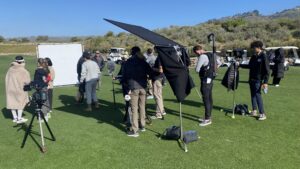Aerial drone videography has transformed filmmaking, offering unique perspectives that were once reserved for high-budget productions. As demand grows, Las Vegas video production companies lead the way, providing breathtaking aerial shots that enhance any project.
Drone filmmaking blends technical skill with artistic vision, turning aerial views into cinematic experiences. Whether working with a video production company Las Vegas or a film production Las Vegas team, the right expertise is essential for capturing the perfect shot.
Success in this field requires proficiency with complex equipment and the ability to craft visual stories that connect with audiences. Partnering with production companies in Las Vegas ensures your aerial footage is both captivating and professionally executed.
In Los Angeles, a city known for its innovation in film and media, our drone videography services are at the forefront of this exciting industry. With our extensive experience flying drones in LA, we have valuable knowledge and insights to share with those interested in exploring drone cinematography.
Whether you want to learn about the technical aspects of flying or improve your storytelling skills, these top 7 pro tips will be your go-to resource. We’ll cover everything from FAA regulations to enhancing your creative vision – all aimed at helping you become a master of aerial drone videography.
Pro Tips for Aerial Drone Videography
1. Utilize an “Apple Box” for Dynamic Shots
When it comes to capturing unique angles and perspectives, having the right equipment is crucial. That’s why we recommend considering the benefits of using an “apple box” during your shoots. This versatile tool can significantly enhance your footage by providing stable support or even serving as a makeshift pedestal for your camera.
2. Shoot with the Sony FX6 for Exceptional Footage
The camera you choose plays a vital role in the quality of your drone footage. At Hustl Media, we primarily shoot with the Sony FX6 due to its exceptional image stabilization capabilities and dynamic range. Investing in high-quality equipment like this can elevate your aerial videography to new heights.
3. Master the Art of Interview Filming
Interviews are a powerful storytelling tool, but they can also be challenging to execute effectively. To avoid common pitfalls, such as distractions or awkward on-camera moments, take note of the 5 mistakes to avoid during an interview. By understanding these potential issues and learning how to navigate them, you’ll be able to capture compelling interviews that truly engage your audience.
4. Unleash the Power of Makeup Artists on Set
While drone videography often focuses on capturing breathtaking visuals from above, it’s essential not to overlook the impact of other production elements. For instance, did you know that a makeup artist can significantly contribute to creating characters’ visual identity? Discover the multifaceted role of makeup artists on film sets
1. Mastering the Basics of Drone Videography
Embarking on the journey of drone filmmaking, one must start with a solid grasp of the fundamentals. Drone videography tips are plentiful, yet the true artistry begins with controlling your craft and achieving stable footage. Here’s how you can set a strong foundation in getting started with drone filmmaking:
1. Educate Yourself on Drone Regulations
The airspace is regulated for a reason. Adhering to FAA guidelines and local laws isn’t just about compliance; it’s about safe and respectful flying. Familiarize yourself with no-fly zones and the necessary certifications to operate legally.
2. Scout and Identify Prime Locations
Every scene has a perfect backdrop waiting to be captured from above. Dedicate time to pinpoint the locations that will elevate your footage while respecting privacy rights and airspace restrictions.
3. Gain Control Proficiency
Smooth movements are paramount in drone videography. Attain finesse in fundamental maneuvers such as hovering and graceful turns to ensure your footage is not only stable but also cinematic.
4. Capitalize on Intelligent Flight Features
Today’s drones come equipped with software designed to assist pilots in capturing stunning visuals. From GPS stabilization for steady shots to follow-me mode for dynamic perspectives, these tools are invaluable for enhancing your aerial videography.
Incorporating these initial steps into your practice sets the stage for more advanced techniques, ensuring that when you’re ready to take flight, your skills will truly soar.
Much like understanding the importance of grips in traditional film production, mastering drone basics ensures smooth operations during shoots. The vital role of grip on set, from equipment handling to camera movement and safety measures, makes them the unsung heroes of film production.
As one progresses further into the realm of aerial cinematography, remember that each flight should be approached with the same level of attention and preparation as any other critical role on a film set.
Discover the vital role of a production assistant in a video production company. Much like how every member of the team contributes to success, similarly, each preparatory step in drone videography lays the groundwork for exceptional aerial footage.
2. Applying Filmmaking Principles to Aerial Drone Videography
The art of filmmaking is not limited to the ground; the sky provides a vast opportunity for creativity. Filmmaking principles seamlessly blend into aerial drone videography techniques, going beyond traditional limits to create stunning visuals from above.
Key Filmmaking Principles for Aerial Drone Videography
1. Composition Mastery
The basic rule of framing, known as the rule of thirds, is just as important in aerial shots as it is on land. Here’s how you can apply it:
- Position key elements at the intersecting points of the imaginary grid to create a balanced composition.
- Use leading lines such as roads or rivers to guide the viewer’s gaze through the scene.
- Look for opportunities to create frames within frames by flying through windows or arches, adding depth and complexity to your shots.
2. Lighting and Exposure
Lighting plays a crucial role in setting the mood of a shot, whether it’s in cinema or aerial videography. Here are some tips for mastering lighting and exposure:
- Understand how shadows and highlights can define the landscape, especially during golden hour.
- Be prepared to adapt quickly to changing light conditions.
- Use neutral density filters to manage bright skies and ensure proper exposure for your subject.
3. Dynamic Movement
Adding movement to your shots can make them more visually interesting. Here are two techniques you can use:
- Panning: Smoothly rotate the drone horizontally to capture sweeping shots of the scenery.
- Tilting: Tilt the camera up or down to create a sense of perspective or reveal something hidden.
4. Storytelling Through Flight
While beautiful visuals are important, storytelling is what truly captivates an audience. Here’s how you can incorporate storytelling into your aerial videography:
- Use your drone to unveil landscapes that have a story to tell, whether it’s the grandeur of nature or human achievements.
- Transition between wide shots and close-ups to show both the bigger picture and the smaller details.
- Look for opportunities to capture emotions in your shots, whether it’s through the movement of people or the changing colors of the environment.
Incorporating these techniques can elevate your aerial footage from ordinary to extraordinary. Remember, practice makes perfect, so keep experimenting and refining your skills!
Embracing these principles offers a pathway to transforming aerial drone footage from simple overhead shots to evocative cinematic experiences.
To truly master the art of aerial drone videography, it’s essential to understand that filmmaking principles aren’t limited to ground-level shots. They seamlessly integrate into aerial techniques, allowing you to push the boundaries and create breathtaking visuals from above.
These filmmaking principles can be effectively applied to enhance your aerial drone videography skills. By incorporating composition mastery, lighting and exposure techniques, dynamic movement, and storytelling through flight, you can elevate your footage from ordinary to extraordinary cinematic experiences.
When it comes to composition mastery in aerial shots, understanding the rule of thirds is crucial. Positioning key elements at the intersecting points of an imaginary grid
3. Planning for Successful Aerial Drone Shoots
Effective planning for aerial drone shoots is crucial to the outcome of your videography project. A meticulously crafted plan ensures that when it’s time to fly, you can focus on capturing stunning footage rather than dealing with avoidable issues.
Research and Location Scouting
Location scouting is integral to identifying the perfect backdrop for your aerial footage. Investigate potential sites to discover obstacles or points of interest that can elevate your shots.
Stay informed about regulations and secure the necessary permissions. Ignorance of local laws not only disrupts shoots but can also result in hefty fines or legal trouble.
Pre-flight Checklists
Assemble a pre-flight checklist that covers all your hardware needs:
- Spare batteries
- Memory cards
- Extra propellers
- Necessary cables and chargers
This checklist serves as a fail-safe to ensure nothing vital is overlooked before takeoff.
Weather Considerations
Weather patterns play a pivotal role in flight conditions. Assessing wind speeds, potential for rain, and temperature extremes is imperative; they can greatly impact both the safety and quality of your drone operations.
Leveraging weather forecasting tools can aid in making informed decisions about scheduling shoots.
Contingency Plans
Be prepared for the unpredictable. Developing a set of contingency plans allows you to handle situations like equipment failure or signal interference with minimal disruption to your shooting schedule.
By integrating these strategies into your production workflow, you pave the way for aerial videography that is not only safe but also of professional caliber. It’s this kind of thorough preparation that sets apart successful projects from those hampered by unforeseen complications.
While considering various aspects of video production, it’s also insightful to understand what gear could complement your drone videography, especially if music videos are part of your project scope. Additionally, when expanding your video production toolkit, choosing the right video production company is crucial for achieving a quality end product.
4. Mastering Advanced Techniques for Capturing Professional Shots with Drones
Elevate your aerial videography to professional levels by honing advanced techniques that captivate and impress. One such skill is executing flying through shots, a method where you navigate drones through narrow gaps or complex environments, adding an element of thrill and technical prowess to your footage.
Specialized Shot Techniques
- Tracking Shots: Keep a moving subject in frame while maintaining a smooth trajectory, enhancing the sense of motion and interest.
- Reveal Shots: Start with a close-up and then pull back to unveil expansive landscapes or hidden gems, creating anticipation and surprise.
- Top-Down Perspectives: Employ bird’s-eye views to present patterns, textures, and contexts not seen from the ground, offering viewers a fresh vantage point.
Creative Composition
To craft visually arresting scenes from above:
- Frame subjects using natural elements to guide the viewer’s eye.
- Combine symmetry and asymmetry judiciously for balanced yet dynamic shots.
- Integrate the environment’s geometry with the narrative flow, ensuring every shot tells part of the story.
Camera Settings for Optimal Footage
Maximize your drone camera’s potential by delving into manual settings:
- Adjust exposure levels to accommodate bright skies or shadowed grounds.
- Select white balance that reflects the true colors of the scene, be it the warm hues of sunset or the cool tones of twilight.
- Switch to manual mode for granular control over ISO, shutter speed, and aperture, tailoring each parameter for the desired effect.
When filming in locations like Las Vegas, where dynamic conditions prevail, apply these techniques mindfully. Managing crowds or navigating lights on the Strip requires careful consideration of both creative and practical aspects — similar to what is Overcoming Challenges of Video Production on the Las Vegas Strip entails. Moreover, adhering to regulations is paramount — insights into local rules can be gleaned from Top Regulations for Flying a Drone in Las Vegas.
By mastering these advanced techniques for capturing professional shots with drones, you’ll not only produce stunning visuals but also ensure your work stands out in this rapidly evolving field.
5. Enhancing Your Drone Videos Through Editing and Post-Production
Editing is the crucial stage where raw drone footage is transformed, improving the storytelling and visual appeal of your videos. Post-production editing not only improves your story but also enhances the look to create an immersive experience for viewers.
When it comes to drone video editing techniques, choosing the right post-production software is important. Applications like Adobe Premiere Pro, Final Cut Pro X, and DaVinci Resolve are popular choices, each offering a set of powerful tools designed for cutting, color correction, and effects. Their comprehensive workflows make it easy to combine drone footage with other media.
Essential Editing Techniques for Drone Videos
Here are some important techniques to keep in mind when editing your drone videos:
- Stabilizing shaky clips: Use software stabilization or plugins to smooth out any camera shake and ensure a steady playback.
- Removing propeller distortion: Drones with fast-spinning propellers can sometimes create a distortion effect in the footage. This can be corrected using lens correction tools in your editing software.
- Creating seamless transitions: Use techniques like crossfades or match cuts to create smooth transitions between shots and maintain the flow of your story.
The Power of Color Grading
Color grading is an artistic process that can significantly change the mood and atmosphere of your aerial films. By adjusting colors, contrast, and saturation, you can convey a specific time of day or evoke certain emotions.
Tip: Experiment with different color grading styles to find the look that best suits your video’s theme.
Elevating Your Audio
To further enhance the cinematic quality of your productions, consider paying attention to the audio elements:
- Soundtrack selection: Choose music that complements the mood and pace of your video. There are many royalty-free music libraries available online.
- Sound effects: Add subtle sound effects to enhance key moments in your footage, such as the sound of waves crashing or birds chirping.
- Narration: If appropriate, use voice-over narration to provide context or guide the viewer’s emotional response to the visuals.
The Perks of Being a Videographer in Las Vegas
If you’re a videographer based in Las Vegas, you have access to a unique set of opportunities. The perks of being a videographer in the Sin City are unparalleled – with non-stop energy, creative prospects, and a vibrant visual feast that serves as an ideal backdrop for your drone videos.
By using these editing techniques effectively, you can turn good footage into compelling storytelling that captures the attention of viewers.
Conclusion
To recap the journey through the skies of aerial filmmaking, remember these seven professional drone videography tips:
- Mastering the Basics of Drone Videography: Build a solid foundation in drone operation and understand the legal landscape.
- Applying Filmmaking Principles to Aerial Shots: Adapt traditional cinematography concepts to enhance your drone footage.
- Planning for Successful Aerial Shoots: Scout, prepare, and create checklists to ensure smooth filming experiences.
- Mastering Advanced Techniques: Elevate your skills with sophisticated shooting methods designed to captivate audiences.
- Enhancing Videos Through Editing: Bring your vision to life by refining your raw footage with editing magic.
- Incorporating Sound Design: Use audio elements to add depth and emotion to your aerial narratives.
- Staying Informed on Trends and Technology: Keep abreast of the latest advancements in drone tech and videography trends.
As you start this exciting journey in drone filmmaking, remember to practice intentionally, pushing the boundaries of your creativity. Becoming skilled at drone videography requires consistent effort, with each flight contributing to your expertise.
For those looking for exceptional quality in their projects, consider our drone videography services in LA. With expert guidance and top-notch equipment, we are ready to help you stand out from the crowd.
Curious about film production terminology? Our comprehensive guide on 10 Commonly Used Production Phrases will familiarize you with film set jargon, from “rolling” to “martini shot”, helping you navigate the language of the video production world.
And if you want to witness firsthand how professional drone videography can make a significant difference in a project, take a look at our experience filming Surviving Mann Season 1. It showcases our expertise and the impact aerial shots can have on storytelling.
Get ready for an amazing adventure in the sky; the possibilities in LA are endless!
Frequently Asked Questions (FAQs)
Q: What equipment do I need to get started with drone videography?
A: To begin, you’ll need a reliable drone with a high-quality camera, a gimbal for smooth shots, extra batteries, and SD cards with enough storage. Depending on your level, a drone with 4K video capability is ideal for professional results.
How do I ensure smooth and stable shots with my drone?
To capture smooth footage, make use of your drone’s gimbal, fly at a steady speed, and avoid sudden movements. Use the “Cine” mode or similar low-speed settings that most drones offer for smoother motion.
What are the best weather conditions for filming with a drone?
Ideal conditions for drone videography are mild winds and clear skies. Avoid flying in heavy rain, snow, or high winds to ensure both safety and high-quality footage. Early mornings or late afternoons provide the best lighting.
What are some tips for composing cinematic drone shots?
Focus on composition techniques such as the rule of thirds, leading lines, and framing. Take advantage of wide, sweeping shots, and use elevation changes to add depth and visual interest to your footage.
How can I improve my drone piloting skills for videography?
Practice flying in various environments to improve control and stability. Start with basic maneuvers like hovering and gradual turns before progressing to more advanced techniques like orbiting and following moving subjects.
To book our services, kindly send us an email at Art@HUSTLMedia.com or directly call us at (702) 980 -9620. You may also learn more about us and our campaigns by visiting our website – HUSTL Media.




